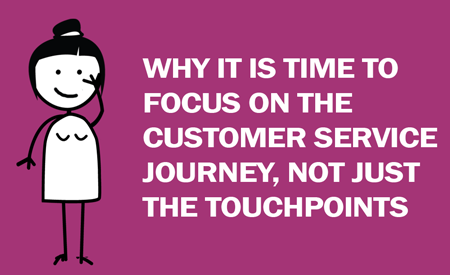Why it is time to focus on the customer service journey, not just the touchpoints

Research shows that 82% of consumers say they’ll switch to a rival if a mistake made at one of these touchpoints* is not addressed. It is easy to see why businesses focus on making every interaction as seamless and high quality as possible.
However, a new report by consultants McKinsey points out the downsides of focusing solely on individual touchpoints rather than also keeping an eye on the bigger picture of the overall customer journey. Given the complexity of today’s multichannel world, companies can excel at providing service on individual touchpoints, but ultimately fail to deliver the customer experience required. This is primarily due to the fact that most customer journeys span multiple departments, systems and silos of information.
Where touchpoints don’t meet
Take the process of onboarding a new customer, this obviously involves a range of departments, from sales, support, finance and marketing. In a project carried out for a European telecoms operator, McKinsey analyzed how the onboarding process worked for its customers. On the positive side, each individual interaction such as talking to a product technician or arranging an installation visit, went well, scoring above 90% in terms of satisfaction. However, happiness with the overall onboarding process fell to 40%. How could this be? It was simply that the entire process was too complex and time-consuming. While customers were satisfied with the service they received, the cumulative effect of the phone calls, emails and letters required left them annoyed and upset.
McKinsey’s example reminds me very much of the experience of my colleague Olivier Njamfa’s own experiences moving house, as detailed in a previous blog. His energy company sent him several enormous bills that were clearly impossibly high for the period he’d been in residence. Each time he spoke to customer services they were apologetic, helpful and said they’d solve the issue. However, he’d then get another large bill and the whole process began again. Suffice it to say, his satisfaction levels were below 40% by the end of the journey.
So, how can companies overcome the issues inherent in taking a touchpoint-by-touchpoint approach to customers, while still ensuring that every interaction is high quality and adds to the overall experience? Based on McKinsey’s ideas, and my own experience, I think there are four ways to address the problem:
1. Take a holistic approach
Most businesses are organized into departments, ensuring that specialists are responsible for specific parts of the customer journey. In many cases this makes sense – you couldn’t expect a sales person to provide the answer to a technical query, for example, but it does lead to the touchpoint and silo-based approach described above. A way around this is to organize cross-functional teams into customer hubs, small groups that possess all the skills required to quickly deal with specific processes, such as onboarding. By sitting people together, it removes silos and ensures the focus is on the customer, not departmental boundaries.
2. Join up systems and make the customer everyone’s priority
Customers become extremely frustrated if the person they are speaking to cannot solve their problem, particularly so if they then have to repeat their issue to the next agent on the line. Companies need to join up systems to make the journey seamless and harness the skills and knowledge of everyone within the organization to support the customer. This could mean bringing in specialist staff who are not normally customer-facing to answer specific queries as part of the process, all managed through a single, integrated workflow that ensures quality and speed of response.
3. Be truly multichannel
Many of the problems within the customer journey come from companies forcing consumers to follow their processes, rather than embracing today’s multichannel world. For example, many organizations mandate that documents are printed and posted (or even faxed!) back to them, when they could be simply filled in online or uploaded securely to their website. Offer customers the channels they want to use, and see where you can remove unnecessary and time consuming stages of the journey.
4. Learn from customers
Evaluate the interactions you have with customers to see what they are thinking and saying. Technologies such as linguistics can be used to analyze digital text based messages at scale to identify tone and subject to give a picture of what customers are thinking about your company and its processes. This information can then be used to fix issues across the journey and increase satisfaction.
Essentially much of this approach revolves around putting yourself in the customer’s shoes and ensuring that everything you do makes their interactions easier, faster and trouble free. A first step is to check how your processes actually work by testing them yourself. For example, how easy is to get answers on particular channels and move along the customer journey? We use exactly this methodology as part of the Eptica Multichannel Customer Experience Study, evaluating how leading brands perform when it comes to delivering service on channels such as email, the web, social media and chat. The 2016 Eptica UK Multichannel Customer Experience Study will be appearing soon, and we look forward to sharing the results with you.
*The touchpoints refer to customer interaction with the business and its employees.







Comments